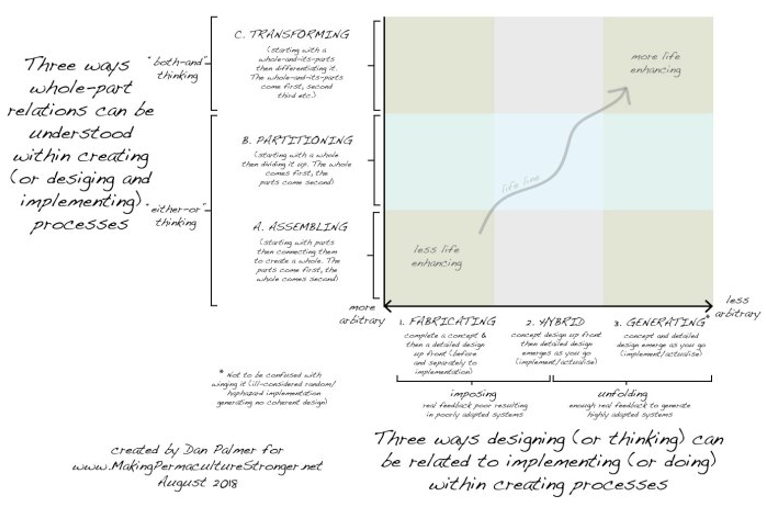The following diagram is a hyper-condensed summary of over two years, 80 posts and 70,000 words worth of this blog’s assorted ramblings about permaculture design. In this three-post series, I’ll try and explain the framework or set of distinctions it shares and what it might (fingers crossed!) have to do with permaculture’s future.

For those of you who are just passing by, please at least read this one sentence summary:
For the rest of you, thanks for sticking around, and let’s commence a less rushed second pass through a significant moment (and milestone!) in the history of making permaculture stronger. I’ll set the scene with a metaphor.
Introduction
One way to sum up this project would be to say it’s been an attempt at something like an acupuncture needle. As I understand it, the idea behind such needles goes something like this. First, you start by carefully observing the patient. Then,1 if you stick the right needle in the right place, in the right way, and to the right depth, you can catalyse something good. You can free up blocked or stagnating energy. You can boost the patient toward vibrance and health.
In my own clumsy, sporadic, and making-it-up-as-I-go-along way, I have been trying my hand at sticking a needle into permaculture. Does this imply I think permaculture has scope for more vibrance and health? It surely does. Furthermore, after years of observing and interacting and thinking and feeling and doing and being I’ve decided to focus my energy (and my needle) on the part of permaculture called design process.2
Please don’t switch off when you hear the word design. Part of my aim is to get across that permaculture is about so much more than design in its conventional sense of making clever drawings before we act.
To me, permaculture is an invitation back and forward into a radically retrofitted way of being and doing humanity. Yet I believe that there is one primary blockage or barrier to permaculture realising its power and potential in this broader sense: the lack of a deep and shared understanding of what it is we’re talking about when we’re talking about design process.
Hence my repeated needling of design process as it is currently understood within permaculture. While the jury is out on whether my efforts will have any lasting value, I have been encouraged by the ratio of appreciative murmurs to pained yelps from the patient :-).
This framework I’m unveiling here has come from my experience of having stuck a couple of different needles into different aspects of permaculture design process.
The diagram introduces and suggests a name for a space that I believe is permaculture’s core business, home territory or primary purpose. While no doubt the language can be improved, I’m tentatively calling this space generative transformation. As we’ll see, generative transformation is a way of going about doing or creating anything, be it a garden, farm, organisation, livelihood, or life.
The diagram and the framework it conveys is intended to be like a new and improved acupuncture needle. It is intended to be conducive to permaculture’s good health. These current posts are an attempt to stick this deeper and more comprehensive needle into permaculture and to wriggle it around a little.
Aside from explaining the diagram’s innards, I’ll be arguing that to the extent it identifies with the bottom-left part of the diagram (what I call fabricated assembly) permaculture diminishes its potential. The invitation and the challenge of this framework is actively exploring pathways toward the top-right. Toward generatively transforming whole systems in life-enhancing directions.3
In the next post, I’ll get stuck into a detailed explanation.4
Endnotes
- assuming of course that a needle is an appropriate tool
- With resonant sentiment from mentors including Dave Jacke who commented early on that “I think that starting the quest for improving permaculture in the realm of design process is a brilliant place to start, because so much flows from that. So much” and David Holmgren, who when recently asked what he thought the most important thing permaculture could be asking itself replied: “I think it is a deeper and hopefully more shared understanding of design process. Not in the sense of a narrowing down, or agreement but a deeper exploration because that’s what we say we’re doing all the time, everywhere, in relation to everything, and it’s not the outcomes and the sources it’s what is the actual process we are using”
- For the record this is no small ask – it requires collaborative and deep work of unravelling and escaping from culture-wide ruts in how we are socialised to go about things – but if that sort of thing is not permaculture’s cup of tea, then, I ask you, what is!
- Oh yes and I thank James Andrews, Delvin Solkinson, and John Carruthers for feedback on a draft of this post









